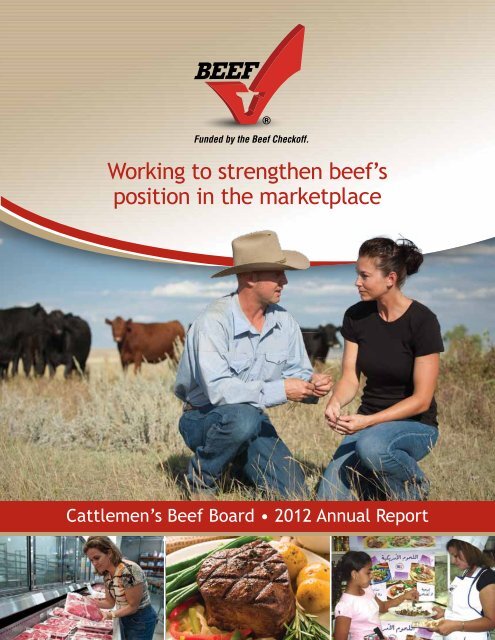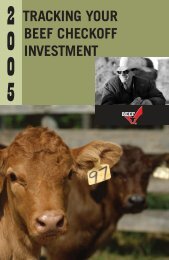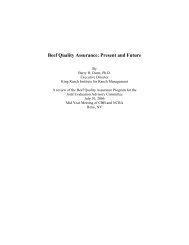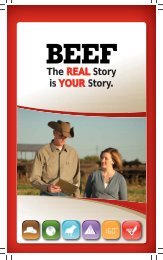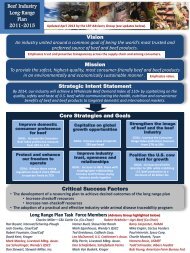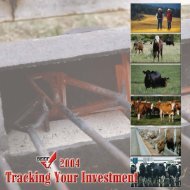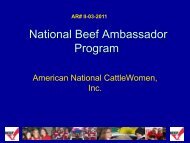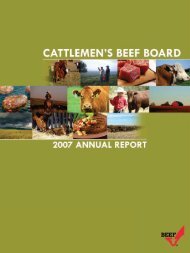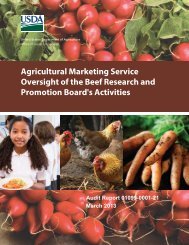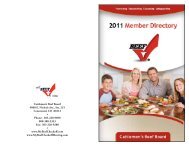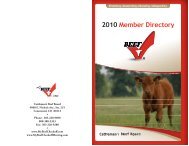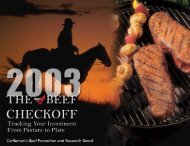2012 Beef Board Annual Report - Cattlemen's Beef Promotion and ...
2012 Beef Board Annual Report - Cattlemen's Beef Promotion and ...
2012 Beef Board Annual Report - Cattlemen's Beef Promotion and ...
Create successful ePaper yourself
Turn your PDF publications into a flip-book with our unique Google optimized e-Paper software.
Funded by the <strong>Beef</strong> Checkoff.<br />
Working to strengthen beef’s<br />
position in the marketplace<br />
Cattlemen’s <strong>Beef</strong> <strong>Board</strong> • <strong>2012</strong> <strong>Annual</strong> <strong>Report</strong>
Dear Fellow Producers,<br />
As we reflect back on Fiscal Year <strong>2012</strong>, the beef industry has seen changes throughout the<br />
market chain. Our <strong>Beef</strong> Checkoff Program has been there to represent our industry <strong>and</strong><br />
share our story with consumers in the U.S. <strong>and</strong> around the world. As <strong>Beef</strong> <strong>Board</strong> members,<br />
I share your commitment to our industry: To perform research, education <strong>and</strong> promotion<br />
that enhances producer profitability. CBB’s main responsibility is to make sure our checkoff<br />
dollars are spent correctly, provide oversight for checkoff expenditures, <strong>and</strong> get the most<br />
mileage that we can out of each dollar invested.<br />
Looking back on <strong>2012</strong>, here are a few of the highlights of checkoff work you can be proud of:<br />
• Discovering new, h<strong>and</strong>-held products: J.M. Garret Foods, Inc., worked with the checkoff’s <strong>Beef</strong> Innovations<br />
Group to roll out three new fun appetizer products loaded with beef <strong>and</strong> other quality ingredients, including the<br />
Philly Cheesesteak Bites, <strong>Beef</strong>y Queso Bites <strong>and</strong> Reuben Bites.<br />
• Sharing the findings of the BOLD nutrition study <strong>and</strong> how lean beef fits a healthy lifestyle: The BOLD study<br />
was published in the American Journal of Clinical Nutrition.<br />
• Conducting the 2011 National <strong>Beef</strong> Quality Audit that shows our industry’s continued commitment to quality:<br />
The checkoff has issued a number of fact sheets <strong>and</strong> final reports detailing what we as producers can do to<br />
improve quality on our farms <strong>and</strong> ranches <strong>and</strong> then communicate that back to the consumer.<br />
• Exports into foreign markets: The population outside the U.S. is growing steadily <strong>and</strong> expected to continue to<br />
do so through at least 2050. If you calculate the population on a country-by-country basis, you’ll discover that<br />
the population of the United States represents just 4.5 percent of the world population. All told, there are 22<br />
times as many consumers outside of the U.S. as there are within our borders, which gives us a clear sense of the<br />
opportunities to grow sales of our end product through exports. Today, the checkoff is promoting U.S. beef in<br />
more than 80 of the 228 countries across the globe, <strong>and</strong> working toward exp<strong>and</strong>ing that wherever <strong>and</strong> whenever<br />
opportunity knocks.<br />
Another thing I want to reemphasize is the importance of our checkoff’s state/national partnership. I’m proud that<br />
since the start of the checkoff 26 years ago, producers in the U.S. have contributed millions of dollars every year to<br />
help keep the beef industry competitive with other proteins. That money has helped us target heavily populated urban<br />
areas, like New York <strong>and</strong> California. And, with these dollars we’re reaching “millennials” — those born between 1980<br />
<strong>and</strong> 2000 — a priority target group for the beef industry as they will soon become the dominant group in society.<br />
Checkoff-funded market research has also found that perceptions about beef are more positive than perceptions about<br />
the way cattle are raised. This gap will be a critical, ongoing measure of the effects of communications <strong>and</strong> issues<br />
management programs designed to inform <strong>and</strong> reassure consumers about beef production. To address these everchanging<br />
consumer needs in the coming year, the checkoff has developed a new committee structure that will make us<br />
more focused on consumer preferences in order to achieve greater program results. <strong>Beef</strong> is the No. 1 protein <strong>and</strong> our<br />
checkoff programs are geared to keep it that way!<br />
We have been charged with feeding our nation <strong>and</strong> the world. That requires you to spend time away from your farms,<br />
ranches <strong>and</strong> businesses, but in doing that, we keep beef top-of-mind with consumers around the globe. So get to<br />
know your checkoff better through this <strong>2012</strong> annual report. And, from my ranch in New Mexico to yours, thank you<br />
for your investment in this industry we all care so much about. I’m looking forward to a wonderful 2013.<br />
Warm regards,<br />
Wesley Grau<br />
Grady, New Mexico<br />
<strong>2012</strong> Chairman<br />
Cattlemen’s <strong>Beef</strong> Research <strong>and</strong> <strong>Promotion</strong> <strong>Board</strong>
<strong>2012</strong> Cattlemen’s <strong>Beef</strong> <strong>Board</strong> Leadership<br />
Seated left to right: Vice Chairman Weldon Wynn, Arkansas; <strong>Beef</strong> <strong>Board</strong> Chairman Wesley Grau,<br />
New Mexico; Secretary/Treasurer Kim Brackett, Idaho; CBB Chief Executive Officer Polly Ruhl<strong>and</strong><br />
<strong>2012</strong> <strong>Beef</strong> <strong>Board</strong> Members<br />
<strong>Beef</strong> <strong>Board</strong> members are nominated by fellow producers in their respective<br />
states or regions. The U.S. Secretary of Agriculture appoints producers to the<br />
<strong>Board</strong> from these nominations, <strong>and</strong> the U.S. Department of Agriculture oversees<br />
the <strong>Board</strong>. Each <strong>Board</strong> member serves a three-year term <strong>and</strong> may serve a<br />
second consecutive term if reappointed. <strong>Beef</strong> <strong>Board</strong> members serve without<br />
compensation. In <strong>2012</strong>, <strong>Beef</strong> <strong>Board</strong> members represented 10 different sectors of<br />
the beef industry with the largest being cow-calf. There are no packer seats on<br />
the <strong>Beef</strong> <strong>Board</strong>.<br />
Barbara Jackson<br />
Tucson<br />
AZ<br />
Leo Sutterfield, Jr.<br />
Mountain View<br />
AR<br />
AR<br />
Weldon Wynn<br />
Star City<br />
Wayne Buck<br />
Ignacio<br />
Phyllis Snyder<br />
Cortez<br />
Andy Wick<br />
Austin<br />
Sarah Childs<br />
Lake Placid<br />
Jim LeFils<br />
Osteen<br />
Kim Brackett<br />
Buhl<br />
Dan Hinman<br />
Emmett<br />
Jeanne Harl<strong>and</strong><br />
LaFayette<br />
Andrew Banchi<br />
Kenosha, WI<br />
CO<br />
CO<br />
CO<br />
FL<br />
FL<br />
ID<br />
ID<br />
IL<br />
Importer<br />
<strong>2012</strong> <strong>Beef</strong> <strong>Board</strong> <strong>Annual</strong> <strong>Report</strong><br />
3
OVERVIEW<br />
The aim of the <strong>Beef</strong> Checkoff Program is building beef dem<strong>and</strong>. Dem<strong>and</strong> often is confused with<br />
per capita consumption — a different measure. Consumption is driven by supply <strong>and</strong> is the result<br />
of market conditions, which are affected by many factors, including cattle inventory, natural<br />
disasters, changes in imports <strong>and</strong> exports, <strong>and</strong> growth in the U.S. population — all of which<br />
make less beef available per capita.<br />
Dem<strong>and</strong>, on the other h<strong>and</strong>, is driven by consumer preference, the amount of beef that consumers<br />
will purchase combined with the price they are willing to pay for that beef.<br />
Why Dem<strong>and</strong> Matters<br />
We consume our beef supply in the United States every year, but the benefits to beef producers<br />
<strong>and</strong> the rest of the industry are based on the price at which that supply is sold. The variable is<br />
the price at which we are able to sell that beef to clear the market. If consumer<br />
preference, or dem<strong>and</strong>, for beef is high, we will sell the supply at a higher price.<br />
To have an impact on producers’ bottom lines, consumers have to want beef<br />
products enough to pay strong prices for them.<br />
Do Consumers Prefer <strong>Beef</strong><br />
The short answer is Yes.<br />
U.S. per capita beef consumption has declined in recent years, but that does<br />
NOT mean that consumer preference or dem<strong>and</strong> has waned. In fact, quite<br />
the opposite: Lately, we’ve seen beef prices increase much faster than the rate<br />
of inflation while consumption declined only slightly, which means that<br />
beef dem<strong>and</strong> has remained steady.<br />
Where the <strong>Beef</strong> Checkoff Comes In<br />
The <strong>Beef</strong> Checkoff Program focuses on maintaining strong consumer preference for beef by<br />
providing products <strong>and</strong> qualities in beef that consumers dem<strong>and</strong> — like taste, nutrition,<br />
consistency <strong>and</strong> tenderness — so that consumers are willing pay more for that same quantity<br />
of beef.<br />
In this report, you’ll get information<br />
about some programs your beef<br />
checkoff dollars were invested in<br />
during FY <strong>2012</strong> — <strong>and</strong> how those<br />
investments helped move the<br />
needle on consumer perference.<br />
Industry<br />
Information<br />
$3,866,591; 9.1%<br />
Program<br />
Evaluation<br />
$131,674; 0.3%<br />
Producer<br />
Communications<br />
$1,745,326; 4.1%<br />
Foreign<br />
Marketing<br />
$6,129,529;<br />
14.4%<br />
Program<br />
Development<br />
$198,499; 0.5%<br />
USDA Oversight<br />
$211,065; 0.5%<br />
Administration<br />
$1,632,467; 3.8%<br />
Consumer<br />
Information<br />
$4,513,478;<br />
10.6%<br />
Research<br />
$5,719,714;<br />
13.4%<br />
<strong>Promotion</strong><br />
$18,497,849;<br />
43.4%<br />
Laurie Bryant<br />
Reston,VA<br />
Andrew Burtt<br />
McLean, VA<br />
Stephen Edwards<br />
Washington, D.C.<br />
Kim Holzner<br />
Windsor, CO<br />
Chris Hutton<br />
Chicago, IL<br />
Al Senosiain<br />
Coconut Creek, FL<br />
Don Gurtner<br />
Fremont<br />
Dean Black<br />
Somers<br />
Will Frazee<br />
Emerson<br />
4<br />
Importer<br />
Importer<br />
Importer<br />
Importer<br />
Importer<br />
Importer<br />
IN<br />
IA<br />
IA
Nutrition Research<br />
The “<strong>Beef</strong> in an Optimal Lean Diet (BOLD) study: Effects on lipids,<br />
lipoproteins, <strong>and</strong> apolipoproteins” manuscript was published in the<br />
January <strong>2012</strong> issue of the American Journal of Clinical Nutrition<br />
(AJCN), a top-tier, peer-reviewed nutrition science journal, known as<br />
one of the 100 most influential journals in biology <strong>and</strong> medicine.<br />
The BOLD study, conducted by Penny Kris-Etherton, PhD, RD, <strong>and</strong><br />
her team at The Pennsylvania State University, provides evidence that<br />
the inclusion of lean beef as part of a heart-healthy diet is as effective in<br />
lowering heart disease risk as the DASH (Dietary Approaches to Stop<br />
Hypertension) diet — the most recommended heart-healthy diet.<br />
Research<br />
The BOLD study manuscript on the AJCN website was downloaded<br />
nearly 18,000 times — double that of similar studies —<br />
demonstrating the impact of the checkoff-funded research study.<br />
Product Enhancement<br />
An important component of this effort is benchmarking <strong>and</strong> tracking<br />
attributes of beef that contribute to overall quality <strong>and</strong> palatability<br />
as determined by tenderness, juiciness <strong>and</strong> flavor. Tenderness is also<br />
a critically important economic factor, since consumers may pay a<br />
premium for guaranteed‐tender meat products. With funding from<br />
the beef checkoff, the industry has tracked beef tenderness for 20 years<br />
through a series of four National <strong>Beef</strong> Tenderness Surveys. In 2010,<br />
the latest tenderness survey was conducted, <strong>and</strong> despite the increased<br />
prevalence of round cuts in the marketplace <strong>and</strong> less stable aging times,<br />
most steaks evaluated in the 2010 survey were considered tender.<br />
<strong>Beef</strong> Safety<br />
The 10th anniversary of the <strong>Beef</strong> Industry Safety Summit, funded in<br />
part by the beef checkoff, is considered the premier beef safety event<br />
in the country, with more than 230 representatives from all sectors of<br />
the beef supply chain attending. The event featured a special session to<br />
reflect on the pledge the beef industry made 10 years ago committing<br />
to reducing E. coli O157:H7. A new pledge was signed in <strong>2012</strong> to<br />
recommit to reducing the presence of any foodborne pathogens in beef.<br />
Market Research<br />
Checkoff market research has established an annual tracking survey<br />
— the Consumer Image Index (CII) — to measure consumers’<br />
perceptions of beef <strong>and</strong> the beef industry. The <strong>2012</strong> CII found<br />
perceptions about beef to be more positive than perceptions about<br />
the way cattle are raised. The size of this gap will provide an ongoing<br />
measure of the effects of communications <strong>and</strong> issues management<br />
programs designed around beef production.<br />
Kent Pruismann<br />
Rock Valley<br />
Danny Herrmann<br />
Dodge City<br />
Brittany Howell<br />
La Crosse<br />
Steve Irsik<br />
Ingalls<br />
Stacy McClintock<br />
Soldier<br />
Larry Oltjen<br />
Robinson<br />
Perry Owens<br />
Minneapolis<br />
Julianna Jepson<br />
Franklin<br />
Daniel Smith<br />
Stamping Ground<br />
IA<br />
KS<br />
KS<br />
KS<br />
KS<br />
KS<br />
KS<br />
KY<br />
KY<br />
<strong>2012</strong> <strong>Beef</strong> <strong>Board</strong> <strong>Annual</strong> <strong>Report</strong><br />
5
<strong>Promotion</strong><br />
Consumer Advertising<br />
With a spotlight on beef’s delicious lean cuts, the FY <strong>2012</strong> beef<br />
checkoff “Profiles” advertising campaign worked to educate<br />
consumers on the healthfulness of beef while reinforcing consumers’<br />
passion for the product.<br />
The checkoff advertising campaign appeared in 26 national<br />
magazines, including Women’s Day, Parenting, Food Network<br />
Magazine <strong>and</strong> Men’s Health, <strong>and</strong> on satellite radio throughout the<br />
summer, working to shift consumer perceptions about beef in a<br />
positive way. Data from the <strong>Annual</strong> Advertising Tracking Study<br />
showed the power of the messaging with results of a 15 to 20<br />
percent increase in the positive perceptions of beef.<br />
The checkoff’s Facebook advertising campaign proved to be a huge<br />
success, generating more than 334,000 new fans on the “<strong>Beef</strong>. It’s<br />
What’s For Dinner.” page, who engaged with the beef checkoff by<br />
sharing, linking <strong>and</strong> commenting a total of 701,222 times.<br />
The consumer advertising program also secured more than<br />
$1 million worth of free media space to bring the concept of<br />
family farms to life for consumers. These full-page “advertorials”<br />
appeared in popular consumer publications such as<br />
Sports Illustrated, Cooking Light <strong>and</strong> Redbook.<br />
Foodservice<br />
Steak Verrine, one of the recipes featured in the foodservice<br />
BEEFlexible advertising campaign, ranked #1 among Flavor &<br />
the Menu readers according to the publication’s Signet AdEffect<br />
Study. Food Arts magazine recognized the ad for its outst<strong>and</strong>ing<br />
readership response measured through face-to-face interviews with<br />
a national sample of readers. The <strong>2012</strong> BEEFlexible campaign<br />
generated significant leads through the new foodservice “Idea<br />
Bank,” one of the most requested pages on <strong>Beef</strong>Foodservice.com.<br />
More than 30 leading research <strong>and</strong> development chefs from<br />
nationally recognized companies — including Applebee’s,<br />
Whole Foods Markets, HEB, Tyson <strong>and</strong> Cargill — attended the<br />
“beef-immersion” course at the Culinary Institute of America<br />
at Greystone. Chefs received training in culinary innovation,<br />
butchering techniques <strong>and</strong> cooking with alternative beef<br />
cuts. Current industry issues such as product sustainability,<br />
environmental stewardship <strong>and</strong> safety were also discussed.<br />
Genevieve Lyons<br />
Church Point<br />
Andy Salinas<br />
Marion<br />
Larry Echols<br />
Gap Mills, WV<br />
Paul Kent<br />
Mora<br />
John Schafer<br />
Buffalo Lake<br />
Mike McCormick<br />
Union Church<br />
Brenda Black<br />
Deepwater<br />
Kevin Frankenbach<br />
Hannibal<br />
Howard Hardecke<br />
Springfield<br />
6<br />
LA<br />
MI<br />
Mid-Atlantic<br />
MN<br />
MN<br />
MS<br />
MO<br />
MO<br />
MO
Retail<br />
Food City <strong>and</strong> the beef checkoff introduced four American Heart<br />
Association (AHA)-certified extra-lean beef cuts that meet the<br />
AHA criteria for saturated fat <strong>and</strong> cholesterol. Ninety-four Food<br />
City retail stores in Kentucky, Virginia <strong>and</strong> Tennessee displayed the<br />
powerful Heart-Check mark on fresh beef packages, promoting beef’s<br />
role in a healthy diet <strong>and</strong> driving nutrition-conscious shoppers to the<br />
meat case.<br />
A refreshed version of <strong>Beef</strong>Retail.org was launched to make it easier<br />
for retailers to access information to support beef sales at the retail<br />
meat case, <strong>and</strong> as a resource for market intelligence, shopper trends<br />
<strong>and</strong> more.<br />
New Product & Culinary Initiatives<br />
Convenient Fresh <strong>Beef</strong> provides consumers with a variety of fresh<br />
<strong>and</strong> convenient beef product ideas, which help make beef a “fast<br />
food” by allowing consumers to have a delicious fresh beef meal<br />
in less time than it would take using st<strong>and</strong>ard cooking methods.<br />
<strong>Beef</strong> will be sold either in “starter kits” with seasoning packets or in<br />
special microwave packaging.<br />
<strong>Promotion</strong><br />
The checkoff partnered with Garret Foods to launch three new<br />
h<strong>and</strong>-held products this summer: <strong>Beef</strong>y Queso Bites, Philly Steak<br />
Bites <strong>and</strong> Reuben Bites. These products are great for on-the-go<br />
consumers or as appetizers “at-home” or at casual theme restaurants.<br />
The checkoff’s Culinary Innovations Team developed over 15 new<br />
recipes responding to culinary trends <strong>and</strong> popular ethnic flavors.<br />
These new recipes turn simple ground beef <strong>and</strong> top sirloin steak into<br />
chef-caliber dishes <strong>and</strong> can be found on <strong>Beef</strong>ItsWhatsForDinner.com.<br />
Veal<br />
To date, more than 1 million people have read how chefs across the<br />
country are inspired to create fresh veal dishes.Veal breast was the<br />
spotlight ingredient in Food Arts magazine’s “Mystery Basket,” a<br />
feature that provides three chefs with a box of mystery ingredients<br />
<strong>and</strong> challenges them to create an innovative dish. A National<br />
Culinary Review article titled, “Veal’s the Real Deal,” showcased<br />
interviews with top corporate chefs, including Bravo/Brio Restaurant<br />
Group <strong>and</strong> Fleming’s Prime Steakhouse. “Veal Made Easy” was launched<br />
on Twitter <strong>and</strong> Facebook <strong>and</strong> reached over 1,000 “likes.”<br />
Leon Kreisler<br />
Salem<br />
Leo McDonnell<br />
Columbus<br />
Linda Nielsen<br />
Nashua<br />
Lyle Peterson<br />
Hathaway<br />
Al Davis<br />
Hyannis<br />
Kristy Lage<br />
Arthur<br />
Judy Reece<br />
Valentine<br />
Doug Temme<br />
Wayne<br />
Sherry Vinton<br />
Whitman<br />
MO<br />
MT<br />
MT<br />
MT<br />
NE<br />
NE<br />
NE<br />
NE<br />
NE<br />
<strong>2012</strong> <strong>Beef</strong> <strong>Board</strong> <strong>Annual</strong> <strong>Report</strong><br />
7
Consumer Information<br />
Public Relations<br />
Your public relations program is the good news engine for beef.<br />
With materials such as monthly media pitches, fact sheets,<br />
delicious recipes, social media <strong>and</strong> online engagement, positive<br />
beef information is spread across the entire country. In FY <strong>2012</strong>,<br />
the national consumer public relations program generated more<br />
than 2.7 billion media impressions — the number of times<br />
consumers may see or hear a message.<br />
Relevant Content for Media <strong>and</strong> Consumers<br />
Consumers increasingly turn to media <strong>and</strong> online resources for<br />
food inspiration <strong>and</strong> education. Through the “<strong>Beef</strong>. It’s What’s<br />
For Dinner.” social media channels — Facebook (with more<br />
than half a million fans), Twitter, <strong>Beef</strong> So Simple <strong>and</strong> blogger<br />
outreach — the checkoff drives content that helps maintain<br />
<strong>Beef</strong>ItsWhatsForDinner.com as a top-ranked page on Google.<br />
From the Wall Street Journal to Food Network Magazine, there<br />
is no shortage of publications looking to the checkoff for<br />
recipe inspiration, preparation techniques <strong>and</strong> cooking tips.<br />
The checkoff held a deskside tour in New York City, meeting<br />
with more than 10 publications, including Food Network<br />
Magazine, Every Day with Rachael Ray <strong>and</strong> Family Circle, to<br />
re-emphasize the checkoff’s role as an expert resource <strong>and</strong><br />
perform recipe demonstrations.<br />
National <strong>Beef</strong> Cook-Off<br />
The National <strong>Beef</strong> Cook-Off gained nationwide exposure with a<br />
live segment on “Good Company” featuring Chef Jason Roberts.<br />
The segment showcased four beef dishes, <strong>and</strong> Roberts spoke<br />
about why he loves beef <strong>and</strong> how to cut <strong>and</strong> prepare it.<br />
This television component of the “Fabulous Food Show”<br />
sponsorship created awareness <strong>and</strong> additional<br />
media through the Cook-Off’s endorsement<br />
by Chef Roberts.<br />
Retail recipe promotions in nearly 90<br />
grocery stores also created awareness of<br />
the National <strong>Beef</strong> Cook-Off. And, the<br />
promotion paid off in beef sales. In<br />
HAV, Inc. stores, pound sales of top<br />
sirloin increased 65 percent during<br />
this promotion as compared to a<br />
year ago.<br />
Chef Jason Roberts<br />
David Wright<br />
Neligh<br />
Wesley Grau<br />
Grady<br />
Tamara Ogilvie<br />
Silver City<br />
Patty Bikowsky<br />
Madison<br />
E.B. Harris<br />
Warrenton<br />
Woody Barth<br />
Solen<br />
Pat Becker<br />
Selfridge<br />
Jane Clifford<br />
Starksboro, VT<br />
Pete Guglielmino<br />
Kettle Falls, WA<br />
8<br />
NE<br />
NM<br />
NM<br />
NY<br />
NC<br />
ND<br />
ND<br />
Northeast<br />
Northwest
Nutrition Public Relations<br />
Thanks to an educational webinar, thous<strong>and</strong>s of registered<br />
dietitians <strong>and</strong> other health professionals received factual,<br />
scientifically supported nutrition information about beef in a<br />
heart-healthy diet. The webinar was based on the checkoff-funded<br />
<strong>Beef</strong> in an Optimal Lean Diet (BOLD) research study. Also,<br />
following publication of “Evolution of Lean <strong>Beef</strong>” in the journal<br />
Meat Science, more than 9,000 registered dietitians learned how<br />
changes made by the beef community in breeding, feeding <strong>and</strong><br />
trimming practices have increased access to leaner beef choices.<br />
Two other research studies — one on protein <strong>and</strong> another on<br />
healthy aging <strong>and</strong> nutrient-rich foods — were shared with more<br />
than 4,000 subscribers of <strong>Beef</strong> Nutrition News, the beef checkoff’s<br />
e-newsletter for health professionals.<br />
<strong>Beef</strong> Gets BOLD<br />
The checkoff-funded <strong>Beef</strong> in an Optimal Lean Diet (BOLD)<br />
study has realized ongoing media attention since its publication.<br />
The BOLD study findings were included in a feature article titled<br />
“The Meat Manifesto” in Men’s Fitness as well as mentions in<br />
Shape, Reuters, FoxNews.com <strong>and</strong> WebMD.<br />
As part of an online promotion of the study’s results, five<br />
consumer nutrition blogs — She’s A Fit Chick, Sweet Tooth<br />
Sweet Life, Hungry Runner Girl, Green Lite Bites <strong>and</strong> Then<br />
Heather Said — shared with their followers the BOLD study<br />
findings through recipes,<br />
giveaways of The Healthy <strong>Beef</strong><br />
Cookbook <strong>and</strong> how the challenge<br />
changed their preconceived<br />
notions of beef nutrition.<br />
The checkoff hosted its first<br />
Facebook Q&A <strong>and</strong> Twitter<br />
party — resulting in 647,337<br />
impressions — to give consumers<br />
the chance to learn more about<br />
the BOLD study by interacting<br />
with nutrition expert Dr. Mike<br />
Roussell, one of the study’s lead<br />
investigators.<br />
Consumer Information<br />
Davis Denman<br />
Cortl<strong>and</strong><br />
Terry Detrick<br />
Oklahoma City<br />
Brian Healey<br />
Davis<br />
Barbara Jacques<br />
Shidler<br />
Brett Morris<br />
Ninnekah<br />
Terry Wyatt<br />
Hollister<br />
Pat Venable<br />
Klamath Falls<br />
Joyce Bupp<br />
Seven Valleys<br />
Dan Kniffen<br />
Spring Mills<br />
OH<br />
OK<br />
OK<br />
OK<br />
OK<br />
OK<br />
OR<br />
PA<br />
PA<br />
<strong>2012</strong> <strong>Beef</strong> <strong>Board</strong> <strong>Annual</strong> <strong>Report</strong> 9
Industry Information<br />
Issues <strong>and</strong> Reputation Management<br />
A hub that addresses top beef myths, FactsAbout<strong>Beef</strong>.com launched in<br />
July with more than 10 myths posted, including one about “Meatless<br />
Mondays.” Along with the new site, a new Twitter h<strong>and</strong>le —<br />
@<strong>Beef</strong>Facts — was created to help drive users to answers for their<br />
beef questions. In August, the site received 2,250 views, compared to<br />
1,997 for the top page on Explore<strong>Beef</strong>.org during the same time period.<br />
This year, 26 influencers — major retailers, foodservice operators,<br />
conservationists, chefs <strong>and</strong> health professionals — participated in<br />
farm/ranch tours. Prior to the tour, only 42 percent of attendees gave<br />
producers top marks on animal care; post-tour that number more than<br />
doubled. Kansas rancher Debbie Lyons-Blythe was featured in a Girl<br />
Scouts of the USA video series about women entrepreneurs, created by<br />
a past tour attendee.<br />
<strong>Beef</strong> Quality Assurance (BQA)<br />
The 2011 National <strong>Beef</strong> Quality Audit (NBQA) had extensive<br />
enhancements made to its design to provide the industry with direction<br />
on factors beyond the physical characteristics of beef, including food<br />
safety, sustainability <strong>and</strong> animal well-being. To roll out audit results,<br />
the NBQA Executive Summary was published, a 10-minute video<br />
created <strong>and</strong> placed on YouTube, <strong>and</strong> social media messages developed<br />
for Facebook <strong>and</strong> Twitter. Ongoing communications efforts include<br />
audit webinars for specific industry sectors <strong>and</strong> the release of 12 fact<br />
sheets outlining opportunities <strong>and</strong> challenges within the sectors.<br />
The BQA Facilities Design video was created to help<br />
farmers, ranchers <strong>and</strong> cattle feeders better underst<strong>and</strong><br />
how to properly design <strong>and</strong> build facilities for specific<br />
needs. Experts such as Curt Pate <strong>and</strong> Dr. Temple<br />
Gr<strong>and</strong>in shared tips to enhance an operator’s ability to<br />
work cattle in a low-stress environment <strong>and</strong> in a timely<br />
manner to improve the overall experience for the<br />
cattle <strong>and</strong> the h<strong>and</strong>ler. The second video, entitled<br />
BQA Cattle H<strong>and</strong>ling Tips for Cow/Calf<br />
Producers, features Dr. Ron Gill, Curt<br />
Pate <strong>and</strong> Dr. John Maas discussing various<br />
production settings <strong>and</strong> cycles of a cattle<br />
operation to better underst<strong>and</strong> how<br />
the h<strong>and</strong>ler <strong>and</strong> the cattle react to these<br />
differing situations.<br />
Danni Beer<br />
Keldron<br />
Linda Gilbert<br />
Buffalo<br />
Vaughn Meyer<br />
Reva<br />
Gary Sharp<br />
Bath<br />
Linda Crumley<br />
Winder, GA<br />
Craig Kesler<br />
Newberry, SC<br />
Eric Smith<br />
Reform, AL<br />
Willie Bylsma<br />
Oakdale, CA<br />
Ted Greidanus<br />
Tipton, CA<br />
10<br />
SD<br />
SD<br />
SD<br />
SD<br />
Southeast<br />
Southeast<br />
Southeast<br />
Southwest<br />
Southwest
Northeast <strong>Beef</strong> <strong>Promotion</strong> Initiative (NEBPI)<br />
<strong>Beef</strong> was present in a big way at the Boston Marathon. The beef<br />
checkoff partnered with Johnnie’s Foodmaster’s 11 retail stores for a<br />
beef promotion that included recipes <strong>and</strong> nutritional information.<br />
Additionally, 655 sweepstakes entries vied for a gr<strong>and</strong> prize of an<br />
“I Heart Lean <strong>Beef</strong>” engraved iPod <strong>and</strong> a $200 steakhouse gift card.<br />
During the three days leading up to the marathon, an estimated<br />
85,000 runners <strong>and</strong> their families came to the Sports & Fitness Expo,<br />
which provided the perfect opportunity to speak with the world’s most<br />
elite runners about lean beef as a great source of protein. The National<br />
<strong>Beef</strong> Ambassadors were on h<strong>and</strong> to talk with the runners <strong>and</strong> to serve<br />
lean beef samples to the crowd. Sixteen Team BEEF members from<br />
across the United States ran the marathon in their team jerseys.<br />
National <strong>Beef</strong> Ambassadors<br />
The National <strong>Beef</strong> Ambassador Program reached nearly<br />
295,000 consumers <strong>and</strong> 3,500 youth during beef story activities<br />
at both state <strong>and</strong> national levels, increasing the number of impressions<br />
by 19 percent above the previous year. Additionally, 70 percent of<br />
nearly 300 consumers surveyed agreed their opinions about beef<br />
improved as a result of interacting with National <strong>Beef</strong> Ambassadors.<br />
More than 6 million positive beef impressions were realized during<br />
“<strong>Beef</strong> Story” Twitter parties that featured nutrition information,<br />
recipes <strong>and</strong> production messages in <strong>2012</strong>.<br />
The National <strong>Beef</strong> Speakers Bureau exceeded its<br />
goal for consumer impressions by reaching<br />
10,141 meal-time decision makers <strong>and</strong> youth, an<br />
87.8 percent improvement over prior year results.<br />
Pre- <strong>and</strong> post-survey results indicated an 11 percent<br />
average positive shift in beef opinions.<br />
Industry Information<br />
Jimmy Maxey<br />
Fresno, CA<br />
Manuel Rodrigues<br />
Tipton, CA<br />
Annalyn Settelmeyer<br />
Gardnerville, NV<br />
Darrel Sweet<br />
Livermore, CA<br />
Rob Reviere, Jr.<br />
Ripley<br />
Ronnie Yeargin<br />
Greenfield<br />
Hughes Abell<br />
Austin<br />
Tom Alger<br />
Friona<br />
Anne Anderson<br />
Austin<br />
Southwest Southwest Southwest Southwest<br />
TN<br />
TN<br />
TX<br />
TX<br />
TX<br />
<strong>2012</strong> <strong>Beef</strong> <strong>Board</strong> <strong>Annual</strong> <strong>Report</strong> 11
Foreign Marketing<br />
Japan on the Upswing<br />
Once the mainstay of U.S. beef export markets, Japanese trade<br />
peaked in 2001, reaching more than 1.1 billion pounds of U.S.<br />
beef valued at more than $1.6 billion. Those totals declined in the<br />
aftermath of BSE, but continue to rebound despite restrictions<br />
that limit exports to beef from cattle 20 months of age <strong>and</strong><br />
younger.<br />
In Japan, the focus has been on rebuilding consumer confidence<br />
in U.S. beef while targeting markets that offer immediate growth<br />
potential — the yakiniku sector, bento boxes, <strong>and</strong> variety meats<br />
<strong>and</strong> alternative cuts for both national <strong>and</strong> regional retail stores.<br />
As a result, U.S. beef trade with Japan has rebounded to No. 2 in<br />
value <strong>and</strong> No. 3 in volume due to:<br />
• Confidence levels of Japanese consumers in the quality <strong>and</strong> safety of<br />
U.S. beef have nearly tripled over the past four years.<br />
• Exports to Japan were up 23 percent in value on steady volumes in<br />
the first nine months of <strong>2012</strong>, particularly impressive when overall<br />
U.S. beef exports were up 2 percent in value on 12 percent lower<br />
volume.<br />
Central/South America: Up-<strong>and</strong>-Comer for Trade<br />
Working against a global market where beef imports are generally<br />
down, Central <strong>and</strong> South America have emerged as top growth<br />
markets for U.S. beef — purchasing 57.7 million pounds of U.S.<br />
beef valued at $99.2 million, increases of 36 percent in volume<br />
<strong>and</strong> 73 percent in value. That growth is even more astounding<br />
when considering that it comes on the heels of significant annual<br />
gains — more than 50 percent in volume <strong>and</strong> more than 85<br />
percent in value — over the previous two years.<br />
US beefconsumer perception<br />
Would you buy US beef<br />
70%<br />
60%<br />
50%<br />
40%<br />
30%<br />
20%<br />
10%<br />
0%<br />
22.9%<br />
Yes!<br />
64.1%<br />
Yes!<br />
2007.11 2011.12<br />
In 2011, 64% of consumers say they will buy American beef.<br />
Number of Japanese consumers who are willing to buy US beef is increasing.<br />
SourceUSMEF Online Tracking Survey, 300 samples<br />
Central/South America<br />
U.S. <strong>Beef</strong> Exports<br />
90<br />
80<br />
70<br />
60<br />
50<br />
40<br />
30<br />
20<br />
10<br />
0<br />
2007 2008 2009 2010 2011<br />
Value in<br />
Million $<br />
Bruce Dopslauf<br />
LaGrange<br />
Leroy Ezer<br />
Anahuac<br />
Chuck Kiker III<br />
Beaumont<br />
Paul Looney, Jr.<br />
Mineral<br />
Jackie Means<br />
Van Horn<br />
Larry Pratt<br />
Eliasville<br />
Andrea Reed<br />
Dodd City<br />
Sugie Sartwelle<br />
Sealy<br />
Rudie Tate<br />
Wellington<br />
12<br />
TX<br />
TX<br />
TX<br />
TX<br />
TX<br />
TX<br />
TX<br />
TX<br />
TX
“My beef checkoff can<br />
help raise consumer confidence in beef.”<br />
“Simply put, our beef checkoff promotes safe,<br />
nutritious beef. All beef producers invest in the<br />
checkoff — so folks like you <strong>and</strong> me decide how to<br />
allocate these dollars to keep our product top-ofmind<br />
with consumers,” says Ronnie Yeargin, a cowcalf<br />
<strong>and</strong> stocker producer from Greenfield, Tenn.<br />
The checkoff is working to build dem<strong>and</strong> for<br />
beef by educating consumers about beef’s role in<br />
healthful diets.<br />
My beef checkoff…reaching consumers with the<br />
benefits of beef.<br />
Ronnie Yeargin<br />
Ronnie Yeargin<br />
Yeargin Farms<br />
Greenfield, Tenn.<br />
Hear more from Ronnie at My<strong>Beef</strong>Checkoff.com<br />
or scan this QR code<br />
Funded by the <strong>Beef</strong> Checkoff.<br />
Paid Media<br />
The producer communications progam continues to feature producer<br />
testimonials with copy <strong>and</strong> video under the theme “My beef checkoff<br />
can…”. Efforts continue to be extended regionally <strong>and</strong> in cooperation<br />
with BQA efforts to help producers get to know their checkoff. A<br />
new measurement tool, called Focus Point, is helping the producer<br />
communications team measure real-time media results <strong>and</strong> make<br />
tactical enhancements to improve effectiveness. Qualified State<br />
<strong>Beef</strong> Councils (QSBCs) are rolling out the national ads, adding<br />
local testimonials or using new “generic” ads available in the newly<br />
redesigned QSBC Toolkit on My<strong>Beef</strong>Checkoff.com.<br />
Earned Media<br />
The checkoff delivered more than 73,000 pieces of mail along with<br />
daily contact with the editors <strong>and</strong> broadcasters, which resulted in<br />
7,200 news placements. Video news packages reached beyond the<br />
traditional 600 TV stations <strong>and</strong> are extended through Facebook,<br />
YouTube <strong>and</strong> other online outlets to thous<strong>and</strong>s of additional viewers.<br />
Direct Communications<br />
The checkoff website, My<strong>Beef</strong>Checkoff.com, is designed as a one-stop<br />
shop for producers to learn how their national beef checkoff dollars are<br />
invested, <strong>and</strong> continues to draw a growing number of visitors, with an<br />
estimated 80,000 unique visitors viewing more than 272,000 pages.<br />
My<strong>Beef</strong>Checkoff.com e-newsletters had an average open rate of<br />
61 percent <strong>and</strong> a click-through rate of nearly 18 percent — both<br />
measures are many times higher than industry averages.<br />
Trade Shows<br />
National producer communications staff, often coordinating with state<br />
beef councils, participates in industry trade shows, including World<br />
Dairy Expo, American Farm Bureau Federation, National Farmers<br />
Union <strong>and</strong> Livestock Marketing Association.<br />
producer communications<br />
Richard Winter<br />
Canyon<br />
Anne Wirtz<br />
Brenham<br />
Laurie Munns<br />
Snowville<br />
Joe Guthrie<br />
Dublin<br />
Hank Maxey, Jr.<br />
Chatham<br />
Marty Andersen<br />
New Glarus<br />
Alvin Bartz<br />
Shawano<br />
R<strong>and</strong>y Geiger<br />
Reedsville<br />
Spencer Ellis<br />
Lovell<br />
TX<br />
TX<br />
UT<br />
VA<br />
VA<br />
WI<br />
WI<br />
WI<br />
WY<br />
<strong>2012</strong> <strong>Beef</strong> <strong>Board</strong> <strong>Annual</strong> <strong>Report</strong> 13
Cattlemen’s <strong>Beef</strong> <strong>Promotion</strong> <strong>and</strong> Research <strong>Board</strong><br />
Financial Statements as of September 30, <strong>2012</strong> <strong>and</strong> 2011<br />
Together with Independent Auditors’ <strong>Report</strong> Thereon<br />
<strong>Board</strong> of Directors<br />
Cattlemen’s <strong>Beef</strong> <strong>Promotion</strong> <strong>and</strong> Research <strong>Board</strong><br />
Independent Auditors’ <strong>Report</strong><br />
We have audited the accompanying statements of assets, liabilities, <strong>and</strong> net assets — modified cash basis of the Cattlemen’s <strong>Beef</strong> <strong>Promotion</strong><br />
<strong>and</strong> Research <strong>Board</strong> (the <strong>Board</strong>) as of September 30, <strong>2012</strong> <strong>and</strong> 2011, <strong>and</strong> the related statements of revenues, expenses, <strong>and</strong> changes in<br />
unrestricted net assets — modified cash basis for the years then ended. These financial statements are the responsibility of the <strong>Board</strong>’s<br />
management. Our responsibility is to express an opinion on these financial statements based on our audits.<br />
We conducted our audits in accordance with auditing st<strong>and</strong>ards generally accepted in the United States of America <strong>and</strong> the st<strong>and</strong>ards<br />
applicable to financial audits contained in Government Auditing St<strong>and</strong>ards, issued by the Comptroller General of the United States. Those<br />
st<strong>and</strong>ards require that we plan <strong>and</strong> perform the audit to obtain reasonable assurance about whether the financial statements are free of<br />
material misstatement. An audit includes examining, on a test basis, evidence supporting the amounts <strong>and</strong> disclosures in the financial<br />
statements. An audit also includes assessing the accounting principles used <strong>and</strong> significant estimates made by management, as well as<br />
evaluating the overall financial statement presentation. We believe that our audits provide a reasonable basis for our opinion.<br />
As described in Note 2, these financial statements were prepared on the modified cash basis of accounting, which is a comprehensive basis of<br />
accounting other than generally accepted accounting principles in the United States of America.<br />
In our opinion, the financial statements referred to above present fairly, in all material respects, the assets, liabilities, <strong>and</strong> net assets of the<br />
<strong>Board</strong> as of September 30, <strong>2012</strong> <strong>and</strong> 2011, <strong>and</strong> its revenues, expenses, <strong>and</strong> changes in unrestricted net assets for the years then ended, on the<br />
basis of accounting described in Note 2.<br />
In accordance with Government Auditing St<strong>and</strong>ards, we have also issued our report dated November 30, <strong>2012</strong> on our consideration of the<br />
<strong>Board</strong>’s internal control over financial reporting <strong>and</strong> on our tests of its compliance with certain provisions of laws, regulations, contracts,<br />
<strong>and</strong> grant agreements <strong>and</strong> other matters. The purpose of that report is to describe the scope of our testing of internal control over financial<br />
reporting <strong>and</strong> compliance <strong>and</strong> the results of that testing, <strong>and</strong> not to provide an opinion on the internal control over financial reporting or<br />
on compliance. That report is an integral part of an audit performed in accordance with Government Auditing St<strong>and</strong>ards <strong>and</strong> should be<br />
considered in assessing the results of our audit.<br />
Our audits were conducted for the purpose of forming an opinion on the financial statements taken as a whole. The accompanying<br />
supplementary statements of assessment revenue by state — modified cash basis is presented for purposes of additional analysis <strong>and</strong> is not a<br />
required part of the financial statements. Such information is the responsibility of management <strong>and</strong> was derived from <strong>and</strong> relates directly to<br />
the underlying accounting <strong>and</strong> other records used to prepare the financial statements. The information has been subjected to the auditing<br />
procedures applied in the audit of the basic financial statements <strong>and</strong> certain additional procedures, including comparing <strong>and</strong> reconciling<br />
such information directly to the underlying accounting <strong>and</strong> other records used to prepare the financial statements or to the financial<br />
statements themselves, <strong>and</strong> other additional procedures in accordance with auditing st<strong>and</strong>ards generally accepted in the United States of<br />
America. In our opinion, the information is fairly stated, in all material respects, in relation to the financial statements as a whole.<br />
In connection with our audits, nothing came to our attention that caused us to believe the <strong>Board</strong> was not in compliance with the provisions<br />
of the <strong>Beef</strong> <strong>Promotion</strong> <strong>and</strong> Research Act of 1985 <strong>and</strong> the <strong>Beef</strong> <strong>Promotion</strong> <strong>and</strong> Research Order (the Order) related to the use of funds<br />
collected by the <strong>Board</strong> insofar as they relate to accounting matters. Further, in connection with our audits, nothing came to our attention<br />
that caused us to believe the <strong>Board</strong> was not in compliance with the terms of Section 1260.149(f) of the Order, or with the terms of the<br />
Agricultural Marketing Service Investment Policy, which describe the type of instruments in which the <strong>Board</strong> may invest, insofar as they<br />
relate to accounting matters. However, our audits were not directed primarily toward obtaining knowledge of such noncompliance.<br />
The report is intended solely for the information <strong>and</strong> use of the members of the <strong>Board</strong> <strong>and</strong> its management, the Audit Committee, <strong>and</strong> the<br />
United States Department of Agriculture <strong>and</strong> is not intended to be <strong>and</strong> should not be used by anyone other than these specific parties.<br />
Clifton Larsen Allen LLP<br />
Greenwood Village, Colorado<br />
November 30, <strong>2012</strong><br />
14
Statements of Assets, Liabilities <strong>and</strong> Net Assets<br />
(Modified Cash Basis, Note 2)<br />
September 30, <strong>2012</strong> <strong>and</strong> 2011<br />
Assets <strong>2012</strong> 2011<br />
Cash <strong>and</strong> Cash Equivalents (Note 3) $ 8,545,965 $ 4,325,154<br />
Short-Term Investments (Note 3) 10,696,000 15,443,950<br />
Capital Assets, net of accumulated depreciation<br />
of $83,941 <strong>and</strong> $99,676, respectively 18,066 21,488<br />
Other 2,252 3,407<br />
Total Assets $ 19,262,283 $ 19,793,999<br />
Liabilities <strong>and</strong> Net Assets<br />
Due to State <strong>Beef</strong> Councils <strong>and</strong> Other $ 1,313 $ 1,517<br />
Net Assets - Unrestricted (Note 5):<br />
Designated for future expenses 10,158,245 13,044,165<br />
Designated - <strong>Board</strong> reserve 4,350,000 4,350,000<br />
Undesignated 4,752,725 2,398,317<br />
19,260,970 19,792,482<br />
Commitments <strong>and</strong> contingencies (Note 9)<br />
Total Liabilities <strong>and</strong> Net Assets $ 19,262,283 $ 19,793,999<br />
Statements of Revenues, Expenses <strong>and</strong><br />
Changes in Unrestricted Net Assets<br />
(Modified Cash Basis, Note 2)<br />
For The Years Ended September 30, <strong>2012</strong> <strong>and</strong> 2011<br />
Revenues <strong>2012</strong> 2011<br />
Assessments (Note 1) $ 41,977,438 $ 41,918,289<br />
Interest 40,812 48,640<br />
Other 96,430 196,143<br />
Total revenues 42,114,680 42,163,072<br />
Expenses<br />
Program Expenses -<br />
<strong>Promotion</strong> 18,497,849 17,782,309<br />
Research 5,719,714 5,732,492<br />
Consumer Information 4,513,478 4,333,552<br />
Industry Information 3,866,591 3,582,286<br />
Foreign Marketing 6,129,529 5,929,362<br />
Producer Communications 1,745,326 1,726,265<br />
Program Evaluation 131,674 156,700<br />
Program Development 198,499 204,923<br />
Total program expenses 40,802,660 39,447,889<br />
Supporting Services -<br />
USDA Oversight 211,065 255,941<br />
Administration (Note 4) 1,632,467 1,970,479<br />
Total expenses 42,646,192 41,674,309<br />
Change in net assets (531,512) 488,763<br />
Beginning unrestricted net assets 19,792,482 19,303,719<br />
Ending unrestricted net assets $ 19,260,970 $ 19,792,482<br />
The accompanying notes to financial statements are an integral part of these statements.<br />
<strong>2012</strong> <strong>Beef</strong> <strong>Board</strong> <strong>Annual</strong> <strong>Report</strong><br />
15
Notes to Financial Statements<br />
(Modified Cash Basis)<br />
September 30, <strong>2012</strong> <strong>and</strong> 2011<br />
(1) Organization <strong>and</strong> Operations<br />
The <strong>Beef</strong> <strong>Promotion</strong> <strong>and</strong> Research Act of 1985 (the Act),<br />
approved on December 23, 1985, by the United States<br />
Congress, established a coordinated program of promotion <strong>and</strong><br />
research designed to strengthen the beef industry’s position in<br />
the marketplace, as well as to maintain <strong>and</strong> exp<strong>and</strong> domestic<br />
<strong>and</strong> foreign markets <strong>and</strong> uses for beef <strong>and</strong> beef products.<br />
As provided in the Act, the Secretary of the United States<br />
Department of Agriculture (the Secretary) issued the <strong>Beef</strong><br />
<strong>Promotion</strong> <strong>and</strong> Research Order (the Order), effective July 18,<br />
1986, which provides the terms <strong>and</strong> conditions for the Act’s<br />
administration. The Cattlemen’s <strong>Beef</strong> <strong>Promotion</strong> <strong>and</strong> Research<br />
<strong>Board</strong> (the <strong>Board</strong>), which was created <strong>and</strong> approved by the<br />
Secretary to administer the Act, consists of 103 members who<br />
are representatives of the cattle industry in the United States,<br />
including importers. <strong>Board</strong> members are appointed by the<br />
Secretary.<br />
The program is financed by a $1 per head assessment on<br />
domestic sales of cattle <strong>and</strong> on imported cattle, beef, <strong>and</strong> beef<br />
products. The <strong>Board</strong>, as part of its responsibilities under the Act<br />
<strong>and</strong> Order, may certify no more than one Qualified State <strong>Beef</strong><br />
Council (Council) in each state <strong>and</strong> authorize that Council to<br />
collect such assessments. The assessments are remitted to the<br />
Councils or the <strong>Board</strong>. The <strong>Board</strong> receives one‐half of assessment<br />
monies from states with Councils <strong>and</strong> the Councils retain the<br />
remainder. The <strong>Board</strong> receives all assessment revenues from<br />
states without Councils <strong>and</strong> from imported cattle, beef, <strong>and</strong> beef<br />
products.<br />
Pursuant to the Act, the <strong>Board</strong>’s expenses for administration<br />
are limited to 5% or less of projected revenues. All remaining<br />
revenues are expended on programs related to promotion,<br />
research <strong>and</strong> information for the beef industry. The <strong>Board</strong><br />
contracts with established national cattle‐ or beef‐industrygoverned<br />
nonprofit organizations for the implementation <strong>and</strong><br />
conduct of these programs. Under the terms of these contracts,<br />
the entities which receive <strong>Board</strong> contracts are subject to annual<br />
audits <strong>and</strong> reviews.<br />
During fiscal years <strong>2012</strong> <strong>and</strong> 2011, the <strong>Board</strong> reimbursed the<br />
following industry organizations for program expenses incurred<br />
on approved projects:<br />
Name of Contractor <strong>2012</strong> 2011<br />
Meat Importers Council of America $490,239 $347,756<br />
National Cattlemen’s<br />
<strong>Beef</strong> Association (NCBA)<br />
National Livestock Producers<br />
Association<br />
$38,040,527 $36,931,474<br />
$35,000 —<br />
American National CattleWomen $161,395 $80,771<br />
The program expenses incurred by NCBA during fiscal years<br />
<strong>2012</strong> <strong>and</strong> 2011 included reimbursements for costs incurred<br />
under subcontracts with the American National CattleWomen<br />
of $408,935 <strong>and</strong> $289,208, <strong>and</strong> the U.S. Meat Export<br />
Federation of $6,129,529 <strong>and</strong> $5,929,362, respectively.<br />
(2) Summary of Significant Accounting Policies<br />
Basis of Accounting<br />
The accompanying financial statements have been prepared<br />
on the modified cash basis of accounting. Under this method,<br />
certain revenues are recognized when received rather than when<br />
earned <strong>and</strong> certain expenses are recognized when paid rather<br />
than when incurred. At September 30, <strong>2012</strong> <strong>and</strong> 2011, there<br />
were assessment receivables of approximately $5,600,000 <strong>and</strong><br />
$6,400,000, interest receivables of approximately $16,000 <strong>and</strong><br />
$11,000, <strong>and</strong> accounts payable of approximately $6,200,000<br />
<strong>and</strong> $7,300,000, respectively, which are not reflected in the<br />
accompanying financial statements. Accounts payable relate to<br />
appropriated expenditures <strong>and</strong> are included in the net assets<br />
designated for future expenses in the accompanying statements<br />
of assets, liabilities <strong>and</strong> net assets (Note 5).<br />
As discussed in Note 1, the <strong>Board</strong> receives one‐half of the<br />
assessment monies collected by the Councils <strong>and</strong> the remainder<br />
is retained by the Councils. The accompanying financial<br />
statements include only the <strong>Board</strong>’s share of assessment monies<br />
<strong>and</strong> do not include amounts related to either revenues or<br />
expenses of the individual Councils.<br />
Cash, Cash Equivalents <strong>and</strong> Short‐Term Investments<br />
For purposes of classifying investments, the <strong>Board</strong> considers<br />
all highly liquid investments with an original maturity of three<br />
months or less to be cash equivalents. Cash equivalents <strong>and</strong><br />
short‐term investments are recorded at cost.<br />
Depreciation<br />
Capital assets, which include equipment <strong>and</strong> leasehold<br />
improvements, are recorded at cost. Depreciation is computed<br />
using the straight‐line method over the estimated useful lives of<br />
three to ten years.<br />
Use of Estimates<br />
The preparation of financial statements require management<br />
to make estimates <strong>and</strong> assumptions that affect certain reported<br />
amounts <strong>and</strong> disclosures, primarily those estimates included in<br />
the Basis of Accounting disclosure above. Accordingly, actual<br />
results could differ from those estimates.<br />
(3) Cash, Cash Equivalents <strong>and</strong> Short-Term<br />
Investments<br />
The Secretary has provided that excess cash may be invested,<br />
on a short‐term basis, in certificates of deposit insured by the<br />
Federal Deposit Insurance Corporation or obligations of the<br />
United States, U.S. Government agencies or U.S. Governmentsponsored<br />
corporations. Cash, cash equivalents <strong>and</strong> short‐term<br />
investments at September 30, <strong>2012</strong> <strong>and</strong> 2011, by investment<br />
type, are as follows:<br />
16
September 30, <strong>2012</strong>:<br />
Dem<strong>and</strong> Deposit<br />
Account<br />
Money Market<br />
Accounts<br />
Certificates of<br />
Deposit<br />
Less —<br />
Outst<strong>and</strong>ing<br />
Checks<br />
Cash<br />
<strong>and</strong> Cash<br />
Equivalents<br />
Short-Term<br />
Investments<br />
Total<br />
Carrying<br />
Value<br />
Total Fair<br />
Value<br />
$7,752,590 $ - $7,752,590 $7,752,590<br />
3,755,634 - 3,755,634 3,755,634<br />
- 10,696,000 10,696,000 10,690,818<br />
(2,962,259) - (2,962,259) (2,962,259)<br />
Totals for <strong>2012</strong> $8,545,965 $10,696,000 $19,241,965 $19,236,783<br />
September 30, 2011:<br />
Dem<strong>and</strong> Deposit<br />
Account<br />
Certificates of<br />
Deposit<br />
U.S. Government<br />
Securities<br />
Less —<br />
Outst<strong>and</strong>ing<br />
Checks<br />
Cash<br />
<strong>and</strong> Cash<br />
Equivalents<br />
Short-Term<br />
Investments<br />
Total<br />
Carrying<br />
Value<br />
Total Fair<br />
Value<br />
$5,922,436 $ - $5,922,436 $5,922,436<br />
- 13,942,002 13,942,002 13,922,093<br />
- 1,501,948 1,501,948 1,500,117<br />
(1,597,282) - (1,597,282) (1,597,282)<br />
Totals for 2011 $4,325,154 $15,443,950 $19,769,104 $19,747,364<br />
In accordance with the <strong>Board</strong>’s policy, the dem<strong>and</strong> deposit<br />
accounts, the money market accounts <strong>and</strong> the certificates<br />
of deposit are insured by the Federal Deposit Insurance<br />
Corporation <strong>and</strong>/or fully collateralized by U.S. Government<br />
securities held at the Federal Reserve Bank in the <strong>Board</strong>’s name.<br />
(4) Administration Expense<br />
The Act limits expenses for the administration of the program<br />
to 5% or less of projected revenues. Projected revenues were<br />
$40,870,000 for <strong>2012</strong> <strong>and</strong> $41,000,000 for 2011. Accordingly,<br />
the administrative expenses incurred by the <strong>Board</strong> were limited<br />
to $2,044,000 in <strong>2012</strong> <strong>and</strong> $2,050,000 in 2011. Administrative<br />
expenses incurred by the <strong>Board</strong> on the accrual basis (versus<br />
modified cash basis amounts reflected in the accompanying<br />
statements of revenues, expenses <strong>and</strong> changes in net assets)<br />
were approximately $1,630,000 (4.0% of projected revenues)<br />
in <strong>2012</strong> <strong>and</strong> $1,950,000 (4.8% of projected revenues) in<br />
2011. Expressed as a percentage of actual revenues, the <strong>Board</strong>’s<br />
administrative expenses were 3.9% in <strong>2012</strong> <strong>and</strong> 4.7% in 2011.<br />
The <strong>Board</strong> has entered into an Administrative Services<br />
Agreement with NCBA whereby NCBA agreed to provide<br />
certain administrative services to the <strong>Board</strong> in return for<br />
reimbursement of all direct <strong>and</strong> indirect costs related to the<br />
provided services. During <strong>2012</strong> <strong>and</strong> 2011, respectively, the<br />
<strong>Board</strong> paid NCBA approximately $58,000 <strong>and</strong> $59,000 related<br />
to this agreement.<br />
The <strong>Board</strong> leases office facilities <strong>and</strong> equipment from outside<br />
third‐parties under operating leases. Payments required under<br />
the leases were approximately $91,000 during <strong>2012</strong> <strong>and</strong> $97,000<br />
during 2011. Future annual payments related to the leases are<br />
approximately $97,000 in 2013, $100,000 in 2014, $46,000 in<br />
2015 <strong>and</strong> $4,000 in 2016.<br />
(5) Unrestricted Net Assets<br />
Unrestricted net assets represent amounts currently available for<br />
the use in the <strong>Board</strong>’s operation in accordance with the Act <strong>and</strong><br />
those resources invested in fixed assets. Designated net asset<br />
balances represent tentative plans of the <strong>Board</strong> for future use of<br />
financial resources, as follows:<br />
Designated for Future Expenses<br />
This balance relates to unexpended program appropriations.<br />
Designated ‐ <strong>Board</strong> Reserve<br />
On October 6, 2010, the <strong>Board</strong> has approved the establishment<br />
of a reserve in the amount of $4,350,000 to be used as the <strong>Board</strong><br />
may deem necessary, with the approval of the Secretary.<br />
Undesignated<br />
As of September 30, <strong>2012</strong> <strong>and</strong> 2011, $4,752,725 <strong>and</strong><br />
$2,398,317 of the net assets had not been designated by the<br />
<strong>Board</strong> <strong>and</strong> is available for budgeting to the various program<br />
areas. Of these amounts, $18,066 <strong>and</strong> $21,488 represent net<br />
assets invested in fixed assets as of September 30, <strong>2012</strong> <strong>and</strong><br />
2011, respectively.<br />
(6) Income Tax Status<br />
The <strong>Board</strong> has received a ruling from the Internal Revenue<br />
Service stating that it is classified as a tax‐exempt entity that<br />
engages in activities under the aegis of the United States<br />
Department of Agriculture.<br />
(7) Pension Plan<br />
The <strong>Board</strong> provides a defined contribution plan for all of its<br />
employees under which annual contributions are provided<br />
based on a percentage of each employee’s salary. Contributions<br />
required <strong>and</strong> funded by the <strong>Board</strong> were approximately $118,000<br />
<strong>and</strong> $120,000 in <strong>2012</strong> <strong>and</strong> 2011, respectively.<br />
(8) Subsequent Event<br />
Management evaluated subsequent events through November<br />
30, <strong>2012</strong>, the date the audited financial statements were available<br />
to be issued. Events or transactions occurring after September<br />
30, <strong>2012</strong>, but prior to November 30, <strong>2012</strong>, that provided<br />
additional evidence about conditions that existed at September<br />
30, <strong>2012</strong> have been recognized in the financial statements for<br />
the year ended September 30, <strong>2012</strong>. Events or transactions<br />
that provided evidence about conditions that did not exist at<br />
September 30, <strong>2012</strong>, but arose before the financial statements<br />
were available to be issued, have not been recognized in the<br />
financial statements for the year ended September 30, <strong>2012</strong>.<br />
In October <strong>2012</strong>, the <strong>Board</strong> <strong>and</strong> the Secretary approved<br />
$3,713,205 of the September 30, <strong>2012</strong> net asset balance as<br />
designated for expenditures in 2013.<br />
(9) Litigation<br />
The <strong>Board</strong> is a defendant in connection with certain legal<br />
actions. While the final outcome of these actions cannot be<br />
determined at this time, management is of the opinion that the<br />
outcome of such matters will not have a material effect on the<br />
financial statements.<br />
<strong>2012</strong> <strong>Beef</strong> <strong>Board</strong> <strong>Annual</strong> <strong>Report</strong> 17
Supplementary Statements of Assessment Revenues By State<br />
For the Years Ended September 30, <strong>2012</strong> <strong>and</strong> 2011<br />
ASSESSMENT REVENUES (Modified Cash Basis) <strong>2012</strong> 2011<br />
Qualified State <strong>Beef</strong> Councils:<br />
Alabama $ 346,952 $ 391,848<br />
Arizona 335,717 285,322<br />
Arkansas 475,693 476,534<br />
California 1,921,761 1,704,276<br />
Colorado 1,668,611 1,651,922<br />
Delaware 6,082 4,566<br />
Florida 317,331 315,411<br />
Georgia 287,163 317,478<br />
Hawaii 16,409 20,596<br />
Idaho 798,165 789,069<br />
Illinois 334,433 343,084<br />
Indiana 239,238 242,663<br />
Iowa 1,680,340 1,755,267<br />
Kansas 3,832,633 3,878,885<br />
Kentucky 706,724 701,259<br />
Louisiana 189,728 163,644<br />
Maine 13,912 13,890<br />
Maryl<strong>and</strong> 47,453 47,479<br />
Michigan 268,879 260,357<br />
Minnesota 660,911 713,397<br />
Mississippi 290,594 383,118<br />
Missouri 1,340,534 1,329,132<br />
Montana 881,788 851,928<br />
Nebraska 3,688,045 3,568,242<br />
Nevada 128,037 137,399<br />
New Jersey 4,738 4,941<br />
New Mexico 655,304 627,241<br />
New York 311,564 299,525<br />
North Carolina 176,464 188,048<br />
North Dakota 538,942 568,096<br />
Ohio 308,475 305,767<br />
Oklahoma 1,936,502 2,208,993<br />
Oregon 417,904 406,192<br />
Pennsylvania 394,712 394,303<br />
South Carolina 80,269 89,502<br />
South Dakota 1,538,686 1,566,257<br />
Tennessee 453,117 456,271<br />
Texas 5,685,045 6,197,659<br />
Utah 293,827 262,192<br />
Vermont 55,809 55,429<br />
Virginia 389,340 391,475<br />
Washington 539,116 538,513<br />
West Virginia 98,355 84,561<br />
Wisconsin 718,343 712,462<br />
Wyoming 530,110 487,399<br />
Total Qualified State <strong>Beef</strong> Councils 35,603,755 36,191,592<br />
States Without Qualified State <strong>Beef</strong> Councils:<br />
Alaska 133 238<br />
Connecticut 13,041 11,486<br />
Massachusetts 18,891 19,920<br />
New Hampshire 15,112 15,765<br />
Rhode Isl<strong>and</strong> 526 656<br />
Total States Without Qualified State <strong>Beef</strong> Councils 47,703 48,065<br />
Importers 6,325,980 5,678,632<br />
Total Assessment Revenues $ 41,977,438 $ 41,918,289<br />
See the accompanying independent auditor’s report.<br />
18
Independent Auditors’ <strong>Report</strong> on Internal Control Over Financial <strong>Report</strong>ing<br />
<strong>and</strong> on Compliance <strong>and</strong> Other Matters Based on an Audit of Financial<br />
Statements Performed in Accordance with Government Auditing St<strong>and</strong>ards<br />
<strong>Board</strong> of Directors<br />
Cattlemen’s <strong>Beef</strong> <strong>Promotion</strong> <strong>and</strong> Research <strong>Board</strong><br />
We have audited the statements of assets, liabilities, <strong>and</strong> net assets — modified cash basis of the Cattlemen’s <strong>Beef</strong><br />
<strong>Promotion</strong> <strong>and</strong> Research <strong>Board</strong> (the <strong>Board</strong>) as of September 30, <strong>2012</strong>, <strong>and</strong> the related statements of revenues,<br />
expenses, <strong>and</strong> changes in unrestricted net assets — modified cash basis for the year then ended, <strong>and</strong> have issued<br />
our report thereon dated November 30, <strong>2012</strong>. As described in Note 2, these financial statements were prepared on<br />
the modified cash basis of accounting, which is a comprehensive basis of accounting other than generally accepted<br />
accounting principles in the United States of America. We conducted our audit in accordance with auditing<br />
st<strong>and</strong>ards generally accepted in the United States of America <strong>and</strong> the st<strong>and</strong>ards applicable to financial audits<br />
contained in Government Auditing St<strong>and</strong>ards, issued by the Comptroller General of the United States.<br />
Internal Control Over Financial <strong>Report</strong>ing<br />
Management of the <strong>Board</strong> is responsible for establishing <strong>and</strong> maintaining effective internal control over financial<br />
reporting. In planning <strong>and</strong> performing our audit, we considered the <strong>Board</strong>’s internal control over financial reporting<br />
as a basis for designing our auditing procedures for the purpose of expressing our opinion on the financial statements,<br />
but not for the purpose of expressing an opinion on the effectiveness of the entity’s internal control over financial<br />
reporting. Accordingly, we do not express an opinion on the effectiveness of the entity’s internal control over<br />
financial reporting.<br />
A deficiency in internal control exists when the design or operation of a control does not allow management<br />
or employees, in the normal course of performing their assigned functions, to prevent or detect <strong>and</strong> correct<br />
misstatements on a timely basis. A material weakness is a deficiency, or combination of deficiencies, in internal<br />
control, such that there is a reasonable possibility that a material misstatement of the entity’s financial statements will<br />
not be prevented, or detected <strong>and</strong> corrected on a timely basis.<br />
Our consideration of internal control over financial reporting was for the limited purpose described in the first<br />
paragraph of this section <strong>and</strong> was not designed to identify all deficiencies in internal control over financial reporting<br />
that might be deficiencies, significant deficiencies or material weaknesses. We did not identify any deficiencies in<br />
internal control over financial reporting that we consider to be material weaknesses, as defined above.<br />
Compliance <strong>and</strong> Other Matters<br />
As part of obtaining reasonable assurance about whether the <strong>Board</strong>’s financial statements are free of material<br />
misstatement, we performed tests of its compliance with certain provisions of laws, regulations, contracts, <strong>and</strong> grant<br />
agreements, noncompliance with which could have a direct <strong>and</strong> material effect on the determination of financial<br />
statement amounts. However, providing an opinion on compliance with those provisions was not an objective of<br />
our audit, <strong>and</strong> accordingly, we do not express such an opinion. The results of our tests disclosed no instances of<br />
noncompliance or other matters that are required to be reported under Government Auditing St<strong>and</strong>ards.<br />
This report is intended solely for the information <strong>and</strong> use of the members of the <strong>Board</strong> <strong>and</strong> its management, the<br />
Audit Committee, <strong>and</strong> the United States Department of Agriculture <strong>and</strong> is not intended to be <strong>and</strong> should not be used<br />
by anyone other than these specified parties.<br />
Clifton Larsen Allen LLP<br />
Greenwood Village, Colorado<br />
November 30, <strong>2012</strong><br />
<strong>2012</strong> <strong>Beef</strong> <strong>Board</strong> <strong>Annual</strong> <strong>Report</strong><br />
19
Cattlemen’s <strong>Beef</strong> <strong>Board</strong><br />
Mission Statement<br />
The Cattlemen’s <strong>Beef</strong> <strong>Promotion</strong> & Research <strong>Board</strong><br />
is dedicated to improving producer profitability,<br />
exp<strong>and</strong>ing consumer dem<strong>and</strong> for beef, <strong>and</strong><br />
strengthening beef’s position in the marketplace.<br />
My<strong>Beef</strong>Checkoff.com<br />
Funded by the <strong>Beef</strong> Checkoff.<br />
Cattlemen’s <strong>Beef</strong> <strong>Promotion</strong> <strong>and</strong> Research <strong>Board</strong><br />
9000 East Nichols Avenue, Suite 215 • Centennial, Colorado 80112 • Phone: 303.220.9890 • Fax: 303.220.9280


